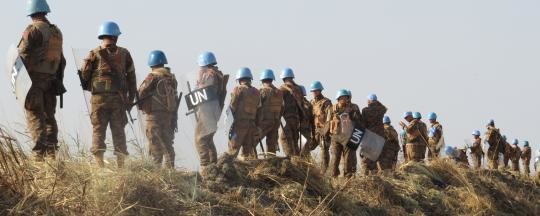Contingency plans made by UN peacekeepers before the start of South Sudan’s civil war called for a time limit of 72 hours for hosting at-risk civilians at their bases before transferring them elsewhere.
Months before the civil war broke out in December 2013, the United Nations Mission in South Sudan (UNMISS) drew up guidelines on how to respond to a massive influx of civilians seeking refuge at UN bases, according to an internal UN document obtained by Radio Tamazuj.
The revelation of a loose plan of “last resort” for protecting civilians within UNMISS bases comes despite the insistence throughout the conflict by former mission head Hilde Johnson that the presence of so many civilians at UNMISS sites could never have been predicted.
A document obtained by Radio Tamazuj entitled “Civilians seeking protection at UNMISS bases” details guidelines to follow in the event that civilians seek protection at UNMISS bases.
The document, available in full below for download and approved by Johnson on 30 April 2013, refers to the ‘preferred option’ of “facilitating protected passage for civilians to move away from danger to another location,” rather than sheltering them at UN bases.
Currently, over 100,000 civilians are under protection of UNMISS in its bases around the country. Many of them have been protected there for six months or more, and on some bases they live in life-threatening humanitarian conditions.
They are risk of abduction, rape, or murder if they venture outside.
‘Temporary measure’
The guidelines say that UNMISS should “preferably” only offer protection to civilians for a few days, with a time frame of 72 hours mentioned repeatedly as the mission’s expectation and capacity for protecting civilians within its walls.
Even so, the guidelines do not rule out the possibility of civilians needing protection over a longer time frame as has happened during the civil war.
In such cases, UNMISS recommended that civilians be moved to protected areas outside its own premises either in another settlement or with host communities after consultation with the South Sudanese government.
“If civilians consider they are still under threat once the immediate crisis has subsided and do not feel that the conditions are adequately safe to return home, UNMISS should consult and liaise with representatives of the civilian population, local authorities, OCHA and UNHCR to facilitate the transition of the civilians to an alternative settlement or within a host community,” reads the document.
In accordance with this advice, UNMISS also recommended that leaders of UNMISS bases develop “proposals for an alternative longer-term solution for protecting the civilians away from the UNMISS bases, in the event that a crisis persists for more than a few days.”
This pre-war policy guidance runs counter to the current UN policy against making population transfers.
A senior UNMISS official explained to Radio Tamazuj in an interview in May that the mission would not physically move groups of people from one area to another, likening doing so to participating in ethnic cleansing.
But the official, Upper Nile State Coordinator Deborah Schein, added that if the mission had the capacity, it could consider protecting civilians moving on their own in line with the UNMISS mandate.
Pre-war precedents
The planning document, drawn up after the recommendation of a UNMISS mission seminar in June 2012, cites previous examples of civilians taking shelter at UNMISS bases including in December 2012 when over 5000 civilians sought protection at UNMISS’ base in Wau, and at least six occasions between October 2012 and March 2013 when civilians requested protection in Pibor.
With these precedents in mind, the mission prepared guidelines for situations where “a handful of individuals to potentially several thousand people” seek shelter at UNMISS facilities, but not numbers as high as 100,000.
UNMISS State Coordinators were instructed to implement the guidelines on a “case-by-case” basis and to go through four detailed phases for civilian protection: prevention, followed by pre-emption, response, and consolidation.
In several striking sections, the document accurately anticipates certain issues that civilians have faced since December 2013, including the ethnic nature of threats, and the threats that they may face while searching for items like firewood outside bases.
This latter point has proved to be a major issue during the civil war as civilians have been raped, beaten, abducted, and killed while searching for essential goods outside of bases. The mission has said it doesn’t have the capacity to protect such individuals.
The document also addressed the question of the mission’s relationship with South Sudan’s government. Supporting the government and state building was at the center of UNMISS’ mandate at the time the guidelines were drawn up.
The guidelines thus recommend close coordination with the government to provide safe passage for civilians to areas of protection and to set up mechanisms to place civilians with host communities or in secure places outside of the camp.
But at the same time, the mission anticipated that the government itself could pose a significant threat to some of its own civilians.
“Indeed, civilians might be seeking protection from GRSS security forces, which might in some cases be perceived as the source of the threat, and the affected civilians might therefore prefer to seek protection from UNMISS in such cases,” the UN document states.
At present, the majority of people currently seeking UN protection are in government-controlled areas.
Photo: UNMISS peacekeepers at the Bentiu base in January 2014 (Courtesy photo/Radio Tamazuj)
For breaking news updates from Radio Tamazuj ‘like’ our page on Facebook, follow us on Twitter, or subscribe to our RSS feed.




